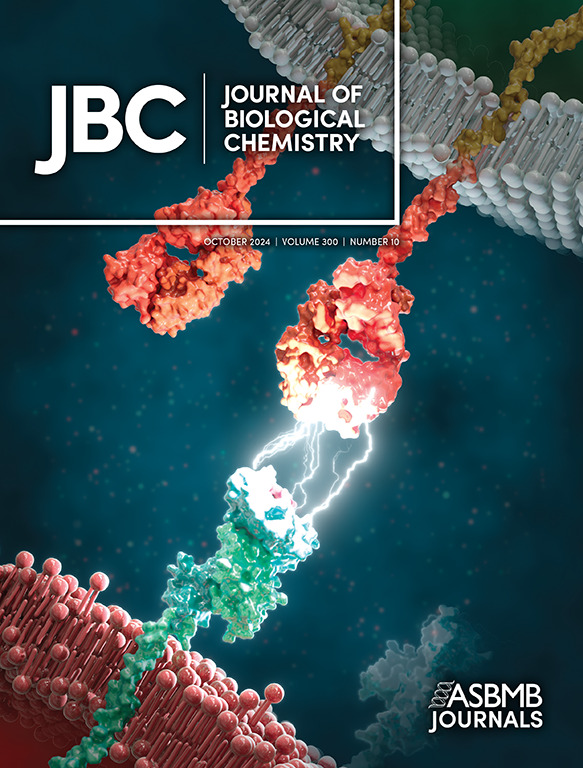CpgD is a phosphoglycerate cytidylyltransferase required for ceramide diphosphoglycerate synthesis
IF 4
2区 生物学
Q2 BIOCHEMISTRY & MOLECULAR BIOLOGY
引用次数: 0
Abstract
LPS is essential in most Gram-negative bacteria, but mutants of several species have been isolated that can survive in its absence.CpgD是合成二磷酸甘油酸神经酰胺所需的磷酸甘油酸胞基转移酶
脂多糖在大多数革兰氏阴性菌中是必不可少的,但已经分离出几种突变体,它们可以在缺乏脂多糖的情况下存活。在缺乏LPS的情况下,月牙根杆菌的生存能力部分依赖于阴离子鞘脂神经酰胺二磷酸甘油酸(CPG2)。遗传分析表明,编码核苷酸转移酶的ccna_01210是CPG2产生所必需的。利用纯化的重组蛋白,我们确定CCNA_01210 (CpgD)是一种磷酸甘油酸胞基转移酶,它利用CTP和磷酸甘油酸生成cdp -甘油,我们假设它是合成CPG2的磷酸甘油酸供体。在镁存在下,CpgD在pH 7.5 ~ 8范围内具有最佳活性。CpgD对3-磷酸甘油酸、d -2-磷酸甘油酸和l -2-磷酸甘油酸表现出Michaelis-Menten动力学。相比之下,CTP在3-磷酸甘油酸和l -2-磷酸甘油酸存在时遵循Michaelis-Menten动力学,但与d -2-磷酸甘油酸表现出协同作用。总之,d -2-磷酸甘油酸是体外首选底物。这种酶的特性揭示了CPG2合成途径的另一个步骤。
本文章由计算机程序翻译,如有差异,请以英文原文为准。
求助全文
约1分钟内获得全文
求助全文
来源期刊

Journal of Biological Chemistry
Biochemistry, Genetics and Molecular Biology-Biochemistry
自引率
4.20%
发文量
1233
期刊介绍:
The Journal of Biological Chemistry welcomes high-quality science that seeks to elucidate the molecular and cellular basis of biological processes. Papers published in JBC can therefore fall under the umbrellas of not only biological chemistry, chemical biology, or biochemistry, but also allied disciplines such as biophysics, systems biology, RNA biology, immunology, microbiology, neurobiology, epigenetics, computational biology, ’omics, and many more. The outcome of our focus on papers that contribute novel and important mechanistic insights, rather than on a particular topic area, is that JBC is truly a melting pot for scientists across disciplines. In addition, JBC welcomes papers that describe methods that will help scientists push their biochemical inquiries forward and resources that will be of use to the research community.
 求助内容:
求助内容: 应助结果提醒方式:
应助结果提醒方式:


